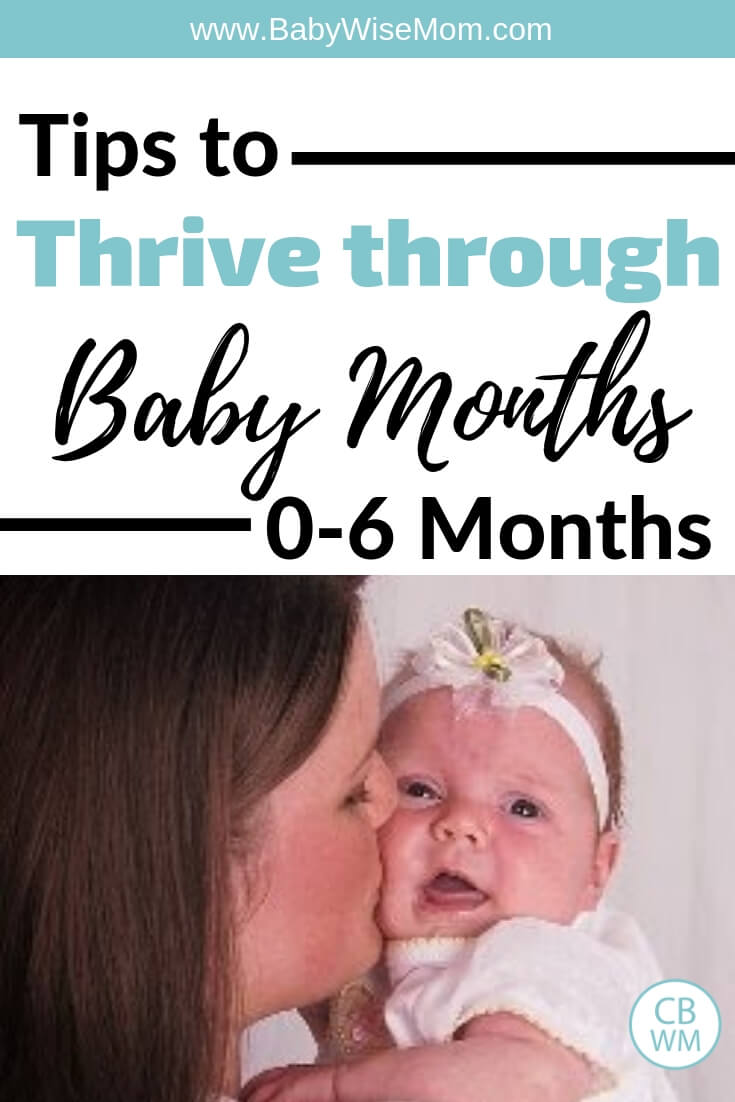More Than Making it Through the Day with your 0-6 month old. Tips to thrive with your baby. Get great naps, playtime, and feeding time.

A goal I have always had as a mother is to do more with my days than simply make it through each one. I wanted to more than surivive each day, but thrive!
Read: More Than Making It Through the Day as a Mom
Post Contents
Goals for Baby’s First 6 Months
The first few months of life with a new baby aren’t that difficult to have goals for. You start off working toward having full feedings. You work on Getting a Consistent Schedule. You sleep train and anxiously wait for your baby to start sleeping through the night.
Let’s review our daily activities and apply goals for this age range.
Mealtime Goals
Week One: As I mentioned above, a main goal of the first week is for baby to take a full feeding. Both parents and baby need to learn how to eat/feed and get things worked out.
Newborn Phase: Part of working on a full feeding is working on getting your baby to stay awake for the feeding. This usually carries on into future weeks. Make the effort to keep baby awake for feedings. It is worth your time. I know it takes your focus and energy. But your baby will be able to take in a full feeding and get on her schedule more consistently if you make the effort to be sure she is staying awake for her full feeding. Also, this applies to all meals–including the ones in the middle of the night. Until week 5, your baby needs 8-10 feedings in a 24 hour period. These need to be full feedings (see Babywise Milestones for more on specific feeding at specific ages). See Baby Whisperer: Feeding a Sleepy Newborn and Sleepy Newborns for ideas on how to keep baby awake.
Proper Intervals: Up until week 5, feedings should be 2.5-3 hours apart, excepting night, when feedings can be at most 5 hours apart. At week 5, some babies can move to 2.5-3.5 hours, though not all. Between weeks 12-15, your baby might be able to go to 3-4 hour schedule. Between weeks 16-24 months, baby should have 4-6 liquid feedings in a 24 hour period. Please take note of the combo suggestions listed here. Combo schedules are okay. Your days do not need to be straight 3’s or straight 2.5’s or straight 4’s. See Combo Schedule is Okay.
Growth Spurts: Make it a goal to recognize and accept growth spurts. Many Babywise parents have a small panic attack when a growth spurt happens. Growth spurts are 100% normal. Don’t ignore it, hoping it will go away. “Problems” will only grow when you ignore the growth spurt. Feed your baby as needed and growth spurts should not be a major disruption to life. Remember that with Babywise, you always feed baby when baby is hungry. See Growth spurt for more.
Tip: Non-BW Tips and Tricks: Breastfeeding moms, give your baby a bottle.
Naptime Goals
First, see My Sleep Hierarchy For Newborns. 0-6 months is perhaps the most tumultuous time for naptime and sleep in your baby’s life. You will have sleep training, 45 minute intruder, nap disruptions of rolling and perhaps sitting up, and a learning curve of getting to know your child. You also can have teething, colds, and growth spurts.
- Self-Soothe: Whatever method you choose to use to teach it, make teaching your baby to self-soothe a goal for this period. See Cry It Out Sleep Training Tips for much, much more. See also Sleep Training: The Four S’s for help on teaching baby to self-soothe with as little CIO as possible.
- Learn Cues: Make it a goal to learn the cues of your baby. See How To Know When Baby is Tired Using Sleep Cues.
- Mom, Not Baby, Decides: This is the time to establish the precedent that mom, not baby, decides when things happen. Please be sure to read this post for more on that: “Mom, not baby, decides…”
- Establish Predictability: This is the time to set the precedent for your sleep routine. Sleep Routine Ideas to Get Your Baby Sleeping Well.
- Remain Calm: Nap troubles will arise. Take them in stride and work through them. See Troubleshooting Naps for helps on solving nap issues.
- Avoid Problems: There are things you can do to avoid sleep problems: Sleep Begets Sleep , Sleep Disruptions You Will Face as a Babywise Mom (and how to deal with them), and When Sleep Props are Okay and When to Avoid Them for more.

Waketime Goals
With the Babywise routine, we follow an eat, wake, sleep schedule. This makes it easier to break down our goals! Here are the goals to consider for your “wake” time each day.
Independent Playtime
If there was one waketime activity principle I chose to take from Babywise, it would be Independent Playtime. I see it as the most valuable waketime activity to have. 0-6 months is not too young to start having your baby play independently. I didn’t start independent play with Brayden until he was 6-7 months old. With Kaitlyn, I started at birth. It was so much easier to implement with Kaitlyn. We never had one day of struggle or tears with Kaitlyn. I really encourage you to start young. See more information in On Becoming Babywise II starting on page 72.
- Newborn: During this phase, just work on staying out of your newborn’s face. The fact she is awake does not mean you need to be working on entertaining her every minute of the day. Let her lay and just observe life around her quietly a couple of times a day. You could also do it for 5-10 minutes during each cycle. Let her learn early on that her company is good enough. I am not suggesting you ignore her all day, just reassuring you that you aren’t a bad parent if you aren’t talking, singing, making funny faces, etc. for every waking moment.
- 3 Months: At some point, you will sense that your baby is ready for more structure to this. You might put her in a bouncer for 5-10 minutes on her own. You might lay her next to a baby-safe mirror to admire herself. You might put her at an activity gym to look at the toys and even bat at them. Work to have her do these things on her own for about 10-20 minutes at least twice a day.
- 4 Months: Your baby will be getting older and more able to do independent play officially. You can still use the alternate mediums. You will need to start removing yourself from her sight since it is much better and she is more aware of her surroundings. You can start placing her in the playpen at this age.
- 5-6 Months: Once your child can sit, increase playpen time to 15-30 minutes a day. You can have a basket of toys that you rotate and vary. You can also have books.
- See Independent Playtime and Independent Playtime Lengths for more.
Sibling Playtime
If your baby has an older sibling(s), you can start sibling playtime from birth. Initially, start with just the older sibling “helping” as possible with baby. Perhaps with the bath. Don’t leave them alone together and don’t let the older sibling overstimulate baby.
As baby gets older, she will love to see the silliness of her sibling(s). She will be fascinated just watching them. Sibling play can move to her just being in the room as the other child(ren) play. The older sibling will likely interact with baby, perhaps singing or just talking. He might show off and try to get a giggle out of younger sister.
This is not an age range I would leave baby alone with older siblings to play. As baby is closer to 6 months, I might be comfortable not sitting right there (depending on age and maturity of older sibling), but I wouldn’t be farther than a couple of steps from them.
Free Playtime
Free playtime doesn’t have to start happening until about 5 months, so don’t worry about it before then. For me, free playtime between ages 0-6 months is more of playing in the jumperoo or bouncy chair or in the high chair with some toys in front of her, etc. Free playtime can be in the presence of other family members. She can sit in her highchair and play while you make dinner. Once she can sit up on her own well, you can give her a basket of toys on the floor to play with. See also How to Use Free Playtime in Your Child’s Schedule.
Bathtime
Bathtime starts as sponge baths and can end in this period with baby sitting in the tub.
- Closeness: This is a good chance to utilize to get close to baby and spend some quality time with your undivided attention.
- Sharing Workload: This is a good activity for Dad to do with baby if possible each day. Moms, you might need to just back off and leave the room. Don’t hover and correct each step your husband takes.
- Teach Appropriate Behavior: As your child approaches 6 months, she will start to be able to possibly do things that aren’t appropriate in the tub. Decide on your tub rules (how much splashing for example) and start your consistency from the beginning if necessary.

One-on-One Time
Make it a point for each parent to have one-one-one time with the baby each day (as possible). Give Dad something that is his special time with baby. Bathtime, getting ready for bed, reading stories, etc. are some ideas. Have this time be time that you as the parent give baby 100% of your time and mental focus. Just enjoy baby. Non-BW Tips and Tricks: Teamwork.
Reading
I start reading to my children from birth. I find this very valuable. We have it as part of our bedtime routine. See The Value of Reading Aloud to Your Children.
Other Waketime Activities
- Wake Baby Up: Initially, it is hard to keep baby awake for waketime. See this post for accomplishing that goal: Adding Waketime to Your Newborn’s Day
- Walks: Walks are great for both you and baby. You can talk to baby as you walk along and tell her about the world she is seeing.
- Toys: See Best Toys for Baby: Ages 0-3 Months and Best Toys for Baby: Ages 4-6 Months for this age range.
- Music: You can sing to your baby or play music CDs for her.
- Infant Massage: This can be nice for you and baby. See Infant Massage.
- Keep it Simple: Realize that your baby does not tire of repetition as soon as you might think. Do watch for signs that a toy or activity is getting to be “old” for her. Keep toys rotated as needed, but she can play with the same toy over and over again for a while before needing something new.
- Optimal Waketime: get to know optimal waketime for your baby: Optimal Waketime Lengths
- Avoid Overstimulation: Playtime: Don’t Over Stimulate
Other Goal Suggestions
- Proper Expectations: New babies can be hard. Realize it, accept it, and love it for what it is. Baby Whisperer: A New Baby is Hard
- Get to Know Baby: Your baby is someone you need to get to know. Take the time to get to know her: Baby Whisperer: Know Your Baby and Get To Know Your Child’s Personality.
- Keep Activities/Toys Appropriate: Baby Whisperer: Learning Triangle
- Baby Whisperer: Start as You Mean to Go On
- Incorporate Baby Into Family: the family does not need to revolve around baby: Going Out, Dealing With Disruptions To Your Routine, Let Your Schedule Serve You: You Don’t Serve Your Schedule (Don’t Stress), but you also need to make sacrifices as you welcome baby to the home: Establishing Consistency–Make Sacrifices.
- Keep Marriage Strong: Keeping your marriage strong is important for your relationship and for your family.
- Enjoy Baby: Enjoy the Moment
Conclusion
There are weeks and days that you just try to make it through the day. There are other times you can do more than that and really set some goals for making the most out of each day!
